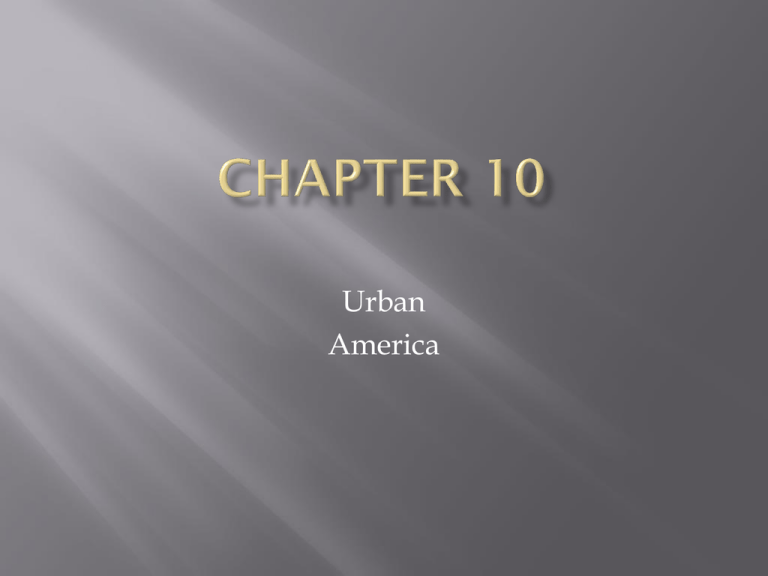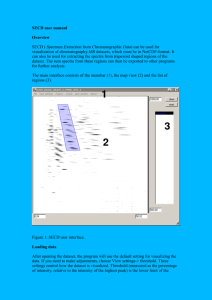Chapter 10-4 - Chadwick School
advertisement

Urban America Chapter 10 Section 4 Guide to Reading Main Idea The pressing problems of the urban poor in the late 1800s and the early 1900s eventually stimulated attempts to reform industrial society. Key Terms and Names • Henry George • Jane Addams • Lester Frank Ward • settlement house • Edward Bellamy • Americanization • naturalism Click the mouse button or press the Space Bar to display the information. Social Criticism • Changes in industrialization and urbanization led to debates among Americans over the issue of how to handle society’s problems. • In 1879 journalist Henry George wrote a best-selling book called Progress and Poverty. • It raised questions about American society and challenged the ideas of Social Darwinism and laissez-faire economics. (pages 353–355) Click the mouse button or press the Space Bar to display the information. Social Criticism (cont.) • In 1883 Lester Frank Ward’s Dynamic Sociology argued that humans were unlike animals because they could think and plan ahead. • He concluded that it was cooperation and not competition that caused people to succeed. • He wanted government to become more involved in solving societal problems. • These ideas became known as Reform Darwinism. (pages 353–355) Click the mouse button or press the Space Bar to display the information. Social Criticism (cont.) • In 1888 Edward Bellamy’s Looking Backward 2000–1887 became a bestseller and helped shape the thinking of American reformers in the late 1800s. • The book tells the story of a perfect society in the year 2000. (pages 353–355) Click the mouse button or press the Space Bar to display the information. Social Criticism (cont.) What was the real importance of Henry George and his writings? George raised questions about American society and challenged the ideas of Social Darwinism and laissez-faire economics. (pages 353–355) Click the mouse button or press the Space Bar to display the answer. Naturalism in Literature • Realists argued that people could control their lives and make choices to improve their situation. • In a style of writing known as naturalism, writers criticized industrial society. • They suggested that some people failed in life due to circumstances they could not control. (page 355) Click the mouse button or press the Space Bar to display the information. Naturalism in Literature (cont.) • Prominent naturalist writers included Stephan Crane, Frank Norris, Jack London, and Theodore Dreiser. • All wrote stories of characters caught up in situations they could not control. (page 355) Click the mouse button or press the Space Bar to display the information. Naturalism in Literature (cont.) What did Jack London’s tales of Alaskan wilderness illustrate? They demonstrated the extreme power that the natural environment can have over civilization. (page 355) Click the mouse button or press the Space Bar to display the answer. Helping the Urban Poor • Reformers began to organize to help the poor. • Organizations such as the Social Gospel movement, Salvation Army, YMCA, women’s clubs, settlement houses, and temperance movements formed to help the needy. • Minister Washington Gladden was an early supporter of the Social Gospel movement. • He wanted to apply “Christian Law” to social problems. (pages 355–357) Click the mouse button or press the Space Bar to display the information. Helping the Urban Poor (cont.) • From 1870 to 1920, members of the Social Gospel group worked to better conditions in cities through charity and justice. • Baptist minister Walter Rauschenbusch later led the movement. • He believed that competition was the cause of many social problems. • This led to many churches taking on community functions to improve society by offering gyms, social programs, and daycare. (pages 355–357) Click the mouse button or press the Space Bar to display the information. Helping the Urban Poor (cont.) • In 1878 the Salvation Army offered aid and religious counseling to urban poor. • The YMCA attempted to help industrial workers and urban poor through Bible studies, prayer meetings, citizenship training, and group activities. • They had facilities that offered libraries, gyms, pools, and low-cost hotel rooms. (pages 355–357) Click the mouse button or press the Space Bar to display the information. Helping the Urban Poor (cont.) • Dwight L. Moody was an evangelical Christian and president of the Chicago YMCA. • He founded his own church, today known as Moody Memorial Church. • By 1867 Moody was so popular that he brought his revival meetings to other cities. • He was against Social Gospel and Social Darwinism. (pages 355–357) Click the mouse button or press the Space Bar to display the information. Helping the Urban Poor (cont.) • He felt the way to help the poor was by redeeming their souls and not by providing them with services. • The settlement house movement was promoted by reformers who felt it was their Christian duty to improve the living conditions of the poor. • Jane Addams set up settlement houses in poor neighborhoods. (pages 355–357) Click the mouse button or press the Space Bar to display the information. Helping the Urban Poor (cont.) • Addams opened Hull House in 1889 and inspired many others, including Lillian Wald’s Henry Street settlement house in New York City. • Medical care, recreation programs, and English classes were provided at settlement houses. (pages 355–357) Click the mouse button or press the Space Bar to display the information. Helping the Urban Poor (cont.) How did Jane Addams and Lillian Wald help the poor? They set up settlement houses that provided poor residents a place to go for medical care, recreation, English classes, and hot lunches. (pages 355–357) Click the mouse button or press the Space Bar to display the answer. Public Education • In the late 1880s, the increase of industry resulted in a need for better-trained workers. • As a result, there was a need for more school and colleges. • Americanization, or becoming knowledgeable about American culture, was key to the success of immigrant children. (pages 357–358) Click the mouse button or press the Space Bar to display the information. Public Education (cont.) • Due to the lack of educational opportunities for African Americans, Booker T. Washington led the crusade to form the Tuskegee Institute in Alabama in 1881. • The grammar school system in the city divided students into eight separate grades to help teach successful habits in the workplace. (pages 357–358) Click the mouse button or press the Space Bar to display the information. Public Education (cont.) • The number of colleges greatly increased in the late 1800s. • This was partly a result of the Morrill Land Grant Act, which gave federal land grants to states for the purposes of establishing agricultural and mechanical colleges. • College attendance increased. • The number of women’s colleges also increased. (pages 357–358) Click the mouse button or press the Space Bar to display the information. Public Education (cont.) • Free libraries provided education to city dwellers. • Andrew Carnegie donated millions toward the construction of libraries. (pages 357–358) Click the mouse button or press the Space Bar to display the information. Public Education (cont.) In what way did public schools pose a problem for immigrants? Parents were afraid their children would become too Americanized and forget their culture and traditions. (pages 357–358) Click the mouse button or press the Space Bar to display the answer. Checking for Understanding Define Match the terms on the right with their definitions on the left. C 1. causing someone to acquire __ A. naturalism American traits and B. settlement characteristics house __ A 2. a philosophy and approach to art and literature based on the belief C. Americanization that nature can be understood through scientific observation and that society functions best with some governmental regulation __ B 3. institution located in a poor neighborhood that provided numerous community services such as medical care, child care, libraries, and classes in English Click the mouse button or press the Space Bar to display the answers. Checking for Understanding (cont.) Describe the way naturalist writers portrayed the fictional characters in their novels. Naturalist writers portrayed their characters as people who failed in life because they were caught up in circumstances beyond their control. Click the mouse button or press the Space Bar to display the answer. Reviewing Themes Individual Action How did the efforts of Jane Addams and Mary Brewster help poor people in urban areas in the late 1800s? Their efforts helped to provide medical care, recreation, English classes, and meals. Click the mouse button or press the Space Bar to display the answer. Critical Thinking Analyzing What role do you think the government should play in the economy? Give reasons to support your opinion. Answers will vary. Click the mouse button or press the Space Bar to display the answer. Analyzing Visuals Analyzing Graphs Examine the graphs on page 354 of your textbook, and then develop a quiz with questions based on specific information found in the graphs. Include at least one broad question about a pattern you see. Give the quiz to some of your classmates. Quizzes will vary. Click the mouse button or press the Space Bar to display the answer. Close Pose and answer questions about the methods that social critics advocated to improve society.




